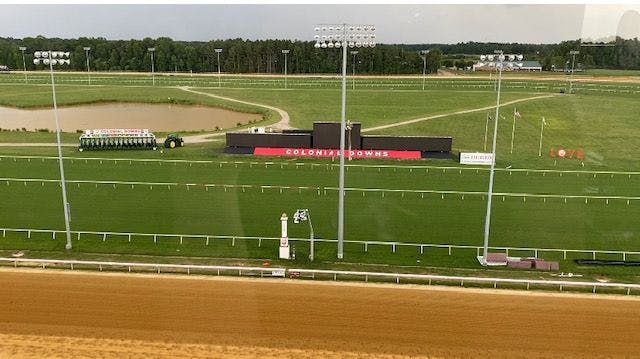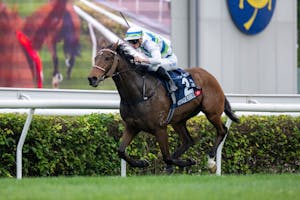Jason Beem's Thursday Column for Feb. 3, 2022

To call the photo or not to call the photo? That is today’s question.
I’ve been wanting to write about this for a while so I’m excited to share my thoughts. Every so often on Twitter, generally from a small group of regular folks who mention this, I’ll see people say something to the effect of “you gotta call that photo!” Or “clearly the 1 won!” Or something along those lines.
To be honest, I’ve thought that too about other callers, and even myself. I’ll watch a race, and on TV it looks like a pretty clear winner watching live and yet the racecaller will say “too close to call” or “photo!”
I would say in the grand scheme of announcers, I’m about an average risk taker when it comes to calling photos. The three biggest factors in calling photos in my opinion are booth location, ability of the racecaller at calling photos, and risk tolerance.
My guiding principle on calling photos is that I never want to incorrectly call a photo in a race. Mostly on the win end, but even if it’s for 4th, I don’t want to be in the business of guessing. So if I truly don’t have a strong sense who got the nod, I”m going to say “photo” or “too close to call” or something to that effect. I know some guys who will call literal noses apart and be right, and more power to them. But they also get burned sometimes. I’d rather have someone mad at me for not calling a photo than calling one wrong.
As I mentioned earlier, booth position is probably the single most important factor in being able to call photo finishes. Because the photo finish camera/room always is what has to be right on the finish line, the announcers booth is almost always gonna be a little ways either up from the line or after it. River Downs was a bit of an exception because it was a double decker press box and the announcers booth was literally maybe 2 or 3 feet left of the line. I think in 2.5 years calling races at River Downs I probably said “photo” just a handful of times because you really could narrow it down to a nose there.
At the same time I was at River Downs, I was calling at Portland Meadows during the winter months. In Portland, the booth was probably 50 feet up the line. So if I could see the inside horse’s nose then I knew he or she won. If I couldn’t, I knew it was close.
Eventually if you’re at a track long enough you start to learn the angles of the booth and can be a little more aggressive with taking a shot at calling the photos. Monmouth Park also had a booth like Portland where it was up the wire about 40 yards or so, which makes Frank Mirahamadi calling Girvin in the 2017 Haskell even more amazing to me. Cause if you ever see the photo, it was so tight and he didn’t have a great shot right on the line!

Here's the view from the booth at Monmouth, about halfway between the finish line and the 70 yard marker.
Well, Jason, why don’t you just look at the TV for photos if it’s closer to the finish line? Well, some callers will. At Keeneland, Kurt Becker is halfway between the 1/16th pole and the finish line, which at Keeneland, both those spots are finish lines. I do believe he will go to the TV with a quick turn to call a photo.
I have never done this until getting to Tampa. I tend to not like having to look at the TV cause it’s just scary to look away from the action in front of you. But a couple of things at Tampa will allow me to take a quick peek at the TV.
First of all, the angle is tricky (see below). Not only am I a fair bit past the wire, but I’m also low. My first day calling there I called a photo where I thought the horse won by a neck or half-length, and he won by a whisker. I knew then I had to be careful. But the other thing I can do at Tampa is, the TV in my booth next to me is about 1 to 1.5 seconds delayed. The feed obviously takes a second to go from camera to the TV room and out to the world. So my pattern has been to watch the race live and if I can’t tell, sneak a quick peek over in that spare second and watch the photo on TV, cause the camera angle is really close to the wire.

This is a zoomed in view of my angle at Tampa Bay Downs. The arrow is the angle of the finish line.
Another thing that can make calling photos tricky is that the turf courses are kinda far out there, especially if the grandstand and track are set back a little bit. The Colonial turf course is very large, and that inner course is way out there. Most races that I call I generally pull off my binoculars at some point just before they get to the 1/16th pole, first because they’re close enough to see with the naked eye, but also so you can have a wider field of view in case someone is rolling on the outside but you were zoomed too far in to see them. But that Colonial inner course I have to keep on my binocs longer, and cause the horses just look smaller and are farther out there, it’s tougher to call. Plus that pesky light pole is in the way lol. In most turf races, the super zoom camera that shoots the shot you’re watching on TV is zoomed in a fair bit to get out to the turf course. So for the naked eye announcer, it’s quite a different view than what you’re seeing on TV.

Here's the view of the finish line for all three courses at Colonial Downs.
Of course there’s all sorts of other reasons a racecaller might take a pass on calling a photo. Heads bobbing at different times makes it tough. Maybe you blinked at just the wrong time. Or maybe the horses are very spread apart, one on the rail, one in the 6 path. That makes calling photos, particularly at an angle, much different than when they’re right next to each other.
I obviously can only speak for myself, but I do think a lot of announcers take pride in calling a close photo. As I said earlier, If I have a strong sense who got it I’ll say it, or I might caveat it with “I think so and so got it.” That’s a trick I learned from Vic Stauffer. A little bit of a hedge so you’re not fully liable! But I just wanted to share some of the reasons why a photo that looks clear to you at home, might not be so cut and dry from four stories up with just your naked eye.
ADVERTISEMENT



